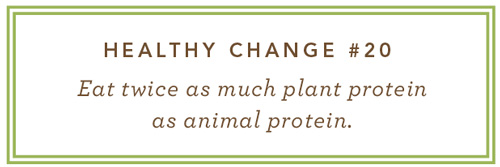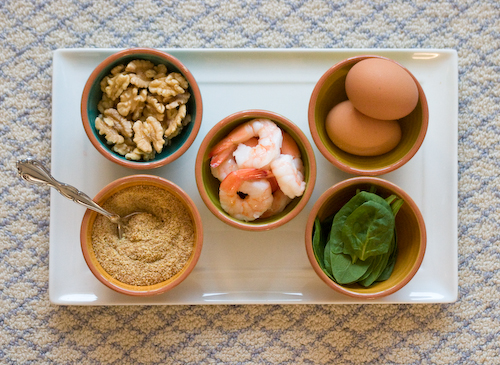What Builds Bones?

The Quick Answer: Calcium (essential for bone health) deficiency is a problem for adolescent girls, menopausal women, and older men. There is growing evidence that getting calcium from whole foods works better than taking it in pill form. The foods in this picture provide 700 mg.
_________________________________________________________________________________________________
In 1939 Dr. Weston Price published a remarkable book, Nutrition and Physical Degeneration. Price studied 13 indigenous civilizations from his expeditions, comparing dental decay in people eating traditional diets to their cousins who had moved to the cities and adopted the modern diet. He concluded that it was possible to prevent dental cavities (or caries) through diet, and that prevention was better than repair. His work was ignored, and the business model for modern dentistry was built on repair rather than prevention. This is a repeating story in nutrition: repair, in our culture, makes a better business than prevention (which requires that so un-American behavior—self-restraint).
I intended to share more about Dr. Price until I discovered that May was National Osteoporosis Awareness & Prevention Month—I almost missed it. Osteoporosis is a lot like dental cavities—repair makes a better business than prevention. Here are a few facts:
• Half of women over fifty will break a bone because of declining bone density; worse, there is the risk of “dowager’s hump.”
• For men the risk of age-related bone fracture is one in four.
• Risk factors for osteoporosis include: insufficient dietary calcium, vitamin D deficiency, excessive intake of protein, sodium, and caffeine, and lack of exercise. (Smoking and heavy alcohol intake are causes also, but if you’re reading this blog you don’t likely have those problems.)
My beautiful wife was upset recently because the doctor gave her a stern lecture for not taking calcium and vitamin D pills. I was puzzled because the doctor had not tested her to see if there was a deficiency, or made a diagnosis of bone loss. He claimed the benefit was well proven; I thought it would be wise to see the proof. My wife is caught between her doctor’s faith in pills, and our faith in wholesome food.
This week the prestigious British Medical Journal reported on a major long-term study that addressed this question; the article was titled “Dietary calcium intake and risk of fracture and osteoporosis: prospective longitudinal cohort study.” (An online digital version is available here.)
The study tracked diet, supplements, and bone fractures in 61,400 postmenopausal Swedish women for nineteen years, starting after they turned fifty. This is the most complete study of diet and bone health to date and the article made these surprising statements:
• There is currently a wide range of daily calcium recommendations: The UK calls for 700 mg; Scandinavia, 800 mg; the U.S., 1200 mg; and 1300 mg in Australia and New Zealand. (These values include dietary calcium and any taken in pill form. Because no one knows how much calcium they get in their diet, these targets are not very helpful.)
• Reviews of prior studies have found little or no benefit to taking calcium in pill form. Eating calcium as part of a healthy diet seems to be best but the optimum amount had not been determined.
• The study concluded that the optimum dietary intake of calcium for postmenopausal women was 700 mg daily. Taking less resulted in more hip fractures; taking more also caused an increase in hip fractures, though at a reduced rate. At lower levels of calcium intake, vitamin D intake was especially helpful.
• Taking calcium in pill form as a supplement did NOT show a benefit.
Based on this major study, we should:
1. Eat more foods rich in calcium. This is critical for adolescent girls, menopausal women, and older men. The most recent data (NHANES 2002-6) showed older women averaging about 560 mg of calcium daily from food sources; men were getting a little more, about 650. Because we already get 51% of our calcium from milk and dairy, getting more from plant sources seems wise as there are other reasons to eat more dark green vegetables, legumes, nuts and seeds. (Plant-sourced calcium also increases estrogen activity in women, and reduces the risk of kidney stones.)
2. Discuss with your doctor the wisdom of taking calcium in pill form; he should be aware of other health considerations. Getting sufficient calcium is a bigger challenge if you avoid milk or dairy. (All this is a tough topic for doctors as they have been guided to push calcium supplements.)
Dietary Calcium
What does 700 mg of calcium from natural foods look like? The picture above tells the story, but here are the details:
• Breakfast of Post Grape Nuts and milk (1/2 cup each): 165 mg.
• Morning snack of cheese (1/2 oz.) and whole wheat cracker: 100 mg.
• Lunch of canned tuna on whole wheat store bread (wheat isn't a significant sourse of calcium; the bread shown is calcium fortified): 87 mg.
• Afternoon snack of yogurt (2 oz.): 100 mg.
• Dinner of spinach salad and a bean dish: 212 mg.
• Evening snack of walnuts, Brazil nuts or sunflower seeds: 30-40 mg.
We’ll come back to bone health in a future post—it’s a complex subject that scientists are still unraveling. Three parting thoughts:
1. Remember that besides dietary calcium, exercise, adequate vitamin D, and avoidance of excessive salt and caffeine are also important to bone health.
2. Strong bones go hand-in-hand with strong muscles. Both peak in our youth; the key to health is to slow the decline.
3. Exercise builds muscles and most muscles are attached at each end to a bone. So besides improving your appearance, exercising your muscles also strengthen your bones.
Please comment on your approach to calcium sufficiency, or your experience protecting bone strength.
 Friday, May 27, 2011 at 12:31PM | by
Friday, May 27, 2011 at 12:31PM | by  Skip Hellewell |
Skip Hellewell |  22 Comments |
22 Comments |  7 References | | in
7 References | | in  calcium,
calcium,  prevention |
prevention |  Email Article
Email Article 















